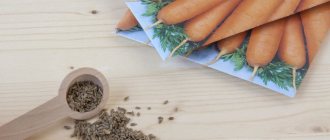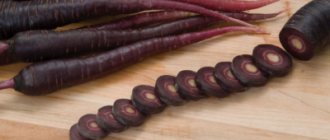Description of the Abaco variety
Abaco F1 is an early hybrid - it ripens in 85-110 days after sowing (the ripening period largely depends on the climate). The tops are powerful, reaching 60 cm in height, bright green, strong, do not fall off and rarely wither. It is grown in large industries, farms and small garden plots.
The tops are powerful and reach 60 cm in height. The root crop is large with a blunt tip, 14-20 cm long, diameter 4-6 cm
The root crop is large, its shape resembles the Chantane variety, with a blunt tip, 14-20 cm long, 4-6 cm in diameter. The average weight of such a carrot ranges from 105-220 grams. The peel is thin, smooth, uniform and dark orange. The color of the pulp is more saturated than the peel - orange-red. The pulp is juicy, sweet and very dense, the core is moderate in size. The composition contains up to 8.4% sugars, 12.4% dry matter and 15-18.6% carotene.
Similar varieties
There are other early orange varieties of carrots of similar weight and size, and Abaco is far ahead of its relatives in terms of yield.
| Characteristics | Abaco F1 | Bangor F1 | Maestro F1 |
| Color and shape of root vegetables |
|
|
|
| Weight, g and size, cm |
|
|
|
| Taste | Good and excellent | Good | Good and excellent |
| Ripening period | Early | Early | Mid-early |
| Productivity, c/ha | More than 1100 | More than 340 | About 880 |
| Storage | For fresh use, processing and winter storage. | For long-term storage. | For fresh use, processing and winter storage, also for growing for bunched products. |
For those who decide to grow carrots in their garden, we suggest familiarizing yourself with the best varieties of this healthy and tasty root vegetable. Our tips will help you get a good harvest. Read about these - Emperor, NIIOH 336, Moscow Winter, Tushon, Canada, Red Cor, Amsterdam, as well as Champion, Queen of Autumn and Red Giant.
The early-ripening dark orange Abaco carrot hybrid will delight gardeners with its sweet taste, ease of care and excellent harvest. It is not difficult to grow it; it is only important to follow the agricultural technology features described in the article.
If you find an error, please select a piece of text and press Ctrl+Enter.
What are the advantages of Abaco F1?
Also check out these articles
- Vegetables: which ones to choose for growing?
- Additives for laying hens
- Chickens Ayam Tsemani
- How to store pears
What advantages can carrots of the Abaco F1 variety please gardeners?
Productivity 420-540 c/ha or 4.6-11 kg/m. kv
- Productivity 420-540 c/ha or 4.6-11 kg/m. sq.
- The commercial quality is excellent and is preserved for a long time after collection.
- The fruits do not crack in the ground and after harvesting too.
- There is resistance to Alternaria and bolting.
- Suitable for manual and mechanical processing and cleaning.
Growing carrots
Growing the abaco carrot variety requires a temperate climate, without frequent temperature changes. It requires both sun and rain, and in sufficient doses. In such conditions, root vegetables do not sprout for long and acquire a pronounced taste. The end of April or the beginning of May is marked by planting carrots if frosts are no longer expected.
If you care for abaco carrot seeds correctly and in a timely manner, the results will only please you. The average vegetable yield ranges from 440 to 560 c/ha. The best yield of 116.4 t/ha was noted in Moscow.
How to choose a location and prepare the soil?
Abaco carrots are grown, like any other species, exclusively in sunny areas. The optimal type of soil is clay-sandy, with a high content of dust, and having a significant depth of the arable layer. pH level – 6.0-6.5. The height of the groundwater is 0.8-2.5 m, but this is a relative criterion, since not every gardener knows how deep the groundwater is on his site.
The optimal type of soil is clay-sand
The crop is always grown after tomatoes, cabbage, onions, cucumbers and potatoes. Before planting, the soil should be fertilized. For this purpose, ash and phosphorus and nitrogen fertilizers are used. They are brought in for digging, then the area is loosened, leveled and left for 1-2 days. If the soil is acidic, it is also worth adding lime, dolomite or chalk.
Harvesting
Harvesting must be done at the right time. It is necessary to wait until the root vegetables reach the required size and turn dark orange.
If the carrots will be stored raw during the winter, they must be dug up at one time. After that, it is sorted, cut and placed in boxes. The layers are separated by sand. You can dip the root vegetables in clay diluted with water and then dry them. This will increase its safety. If root crops are to be processed, they can be harvested separately.
How to germinate and sow seeds?
We recommend reading our other articles
- Grape variety Baikonur
- How to light a smoker for bees
- Radish Duro
- Varieties of gherkin cucumbers
Before sowing, the seeds should be germinated. To do this, they are soaked in a cloth moistened with water for several days. After small sprouts have appeared, they are disinfected with a weak solution of potassium permanganate. This planting material is quite suitable for planting.
In small areas, Abaco F1 carrot seeds can be sown in mid-spring (early to mid-April), when the temperature reaches +5...+7 degrees Celsius. In case of return frosts, the crops are simply covered with film or white agrofibre. But on large plantations, sowing usually occurs at the end of April - mid-May, when the threat of return frosts has passed, since it is very difficult to cover a large area with covering material.
Seeds should be germinated before sowing
The beds can be made to any convenient length, each 5-10 cm wide. Leave up to 15-20 cm of free space between them. The sowing depth is always within 1-3 cm.
Sowing is carried out in well-moistened soil, usually it is watered 2 times with a break of 30 minutes, and only then the seeds are sown. The recommended crop density for large plantations is 0.7 million/ha. In small beds, seeds are sown in a sparse single file; you can also use special seed dispensers. Thickening is not recommended, as this may affect the root crops in the future. It is better to plant less often, but still get a good harvest.
After sowing, the seeds are sprinkled with 1-3 cm of soil and the soil is slightly compacted, but only carefully so as not to damage the sprouts. There is no need to water, as the soil has already been moistened.
What is a unique variety of root vegetable?
Abaco f1 carrot belongs to the Shantane subspecies and is famous for its excellent yield and good taste. From 1 m2 it is possible to collect up to 10 kg of high-quality root vegetables. It is known that it, like other vegetables, is often frozen for the winter: it tends to retain both color and taste under such conditions. It must be said that Abaco f1 carrots enjoy good reviews.
A description of Abaco carrots must begin with what this vegetable looks like. The appearance of the root vegetable stands out for its attractiveness, thanks to its pronounced orange hue. The homogeneous, not small fruits undoubtedly look appetizing, having a length of about 15 cm. The tops reach about 60 cm.
Describing the Abaco carrot variety, it should be said that it:
- powerful and strong, rarely falls and almost never fades;
- has a healthy bright emerald color;
- no flower shoot is observed in the first year of growing season because the growing conditions are not favorable;
- Also, the root crop is not prone to the formation of spotting (alternaria) on the leaves.
Carrots are suitable for a temperate climate and then their yield exceeds 90%. This high-yielding root crop variety was developed by crossing several varieties. Dutch breeding scientists have succeeded in this. The resulting hybrid is strong and does not crack at all. The carrot has a rounded nose, which indicates a sweet-sugar taste.
An outstanding vegetable can be grown both in the country and on farm property. One of the characteristics of abaco carrots is its resistance to cold. She feels great even at -3°C. Root seeds are characterized by good germination (about 94%). This is a good indicator for carrots. The seeds germinate quickly and well, almost 100%.
After the first shoots have appeared, the root crops can be harvested within 3.5 months, so Abaco f1 carrots are considered a mid-season variety. It is known that carrots contain carotene, which contains at least 19 mg. The presence of sugar is quite significant (about 9%).
The only thing is that this Abaco carrot variety, which has gathered mostly positive reviews, attracts all kinds of pest beetles. These insects are also not averse to profiting from juicy fruits. But abaco is the best variety that can resist the invasion of parasites. However, a dangerous pest for these vegetables is the carrot fly. After she has laid eggs, her larvae are born within 5-15 days. They penetrate carrot fruits and cause damage to them. Such carrots become unsuitable for eating.
Important! To overcome a plant disease, you need to apply fertilizers and hill up. Additional effective chemical agents for exterminating parasites are “Pochin” or “Zemlin”.
Are there any difficulties in care?
Carrots of the Abaco F1 variety , like any fruitful, high-quality vegetable in terms of taste and marketability, require systematic care throughout the entire growing season.
Thinning is carried out in at least 2 stages
- Watering is carried out every 10 days. They stop only 1-2 weeks before harvest.
- Fertilizers are always applied at the root! Fertilizers can be mineral (you can find mixtures for carrots in stores or take any phosphorus-potassium substances with added nitrogen) or organic - wood ash. In the latter case, a solution or infusion is made, or you can simply crush the crops with wood ash before watering. Fertilizing is applied approximately 2-3 times per season - you should not overdo it, so as not to spoil the taste of carrots.
- Loosening the soil is an integral part of caring for root crops, especially if the soil is heavy. We weed the area between the rows and directly around the root crops once every 3-5 days, but this must be done carefully so as not to damage the carrots. It is better to use some small tool for caring for indoor plants.
- Thinning is carried out in at least 2 stages. The first time shoots appear, you need to remove large thickenings so that the root vegetables can develop freely without intertwining with each other (this is what always leads to the ugliness of the vegetable). The second thinning occurs during a period of significant increase in carrots, when they are still small, but already edible. Leave 4-5 cm between individual sprouts.
- During the period of almost full ripening, the root crop should peek slightly out of the ground; this is normal for this variety. So it’s not worth raking it with soil, although some gardeners do just that.
Features of cultivation
The agricultural technology of this variety is not too different from the traditional one.
Selecting a location
Carrots will grow well after cabbage, herbs, cucumbers, and tomatoes. It is worth planting onions nearby to prevent damage to the plantings by carrot flies.
Deadlines
Seeds can be planted in the ground from mid-April to mid-May (depending on the growing region). The optimal soil temperature for planting is 5–8 °C.
Preparation
It is necessary to choose a well-lit area for the garden bed; acidic soils must be limed (for example, with dolomite flour). In the fall, when digging, you need to add half a bucket of compost or humus and one and a half cups of ash to the soil.
Adding sand or peat is not relevant for this variety of carrots, because it will give a good harvest even on heavy soil.
Boarding order
- Using a stick or the handle of a shovel, make grooves in the bed at a distance of 20 cm.
- It's good to shed the soil.
- Plant dry seeds into the grooves to a depth of 1.5–2 cm.
- Sprinkle the seeds with fertile soil or peat.
- Cover (if necessary) the plantings with spunbond.
Care
Further care consists of weeding, thinning and watering the plantings. Carrots are thinned out after germination . After the procedure, shoots should remain according to the 20x3 cm pattern. Then they are thinned out again at the stage of bunch ripeness, observing the 20x8 cm pattern.
Water the plantings moderately (the variety does not tolerate excessive humidity), in the evening, with water heated in the sun during the day. The frequency of watering depends on the weather, usually once a week or more. Watering is stopped 2 weeks before harvesting. Manufacturers recommend hilling Abaco carrot plantings several times a season.
Harvest and storage
You can start harvesting Abaco F1 carrots in the last ten days of July. However, the main cleaning takes place in September. Since the variety is early ripening, it is better to use it for food and process it as much as possible. If you still want to keep part of the harvest fresh, you can do this :
- Wash the carrots well, using a special vegetable brush.
- Trim the tail and all the tops, taking part of the root crop.
- Place the carrots in a plastic bag, carefully tying it.
- Place in the refrigerator in the vegetable compartment. Abaco carrots can be stored in it for up to a month.
Abaco F1 carrots can also be stored in a cellar in boxes with sand in the winter, it is only important to store them dry and maintain the required temperature - from 0 to 5 °C.
Diseases and pests
The Abaco variety is resistant to Alternaria and carrot fly, but can be affected by other pests (whitefly, wireworm) and diseases (powdery mildew).
Prevention:
- To protect against insects soil and tops every 2 weeks:
- sprayed with soap and soda solution;
- dusted with tobacco dust;
- scatter ash between the rows.
- To prevent powdery mildew, plantings are sprayed with a whey solution (1 part to 2-3 parts water).
- Sometimes even such an unpretentious variety as Abaco can have problems. These carrots are prone to greening of the root head. To prevent this, it is necessary to hill up the plants several times.
- Sometimes, despite their resistance to cracking, Abaco carrot fruits can become deformed due to excessive watering during hot and dry weather.
To prevent this, it is important to water root crops at the rate of 20 liters per 1 m2 once a week.
Various problems during cultivation and ways to solve them
Harvest and storage
Harvest approximately 85-110 days after sowing
The harvest is harvested approximately 85-110 days after sowing. By this time, the carrots should have reached their maximum size and rich color. From time to time before the collection period, it can be dug up or simply pulled out 1-2 pieces to check.
You can store Abaco F1 carrots for quite a long time in a cool, ventilated and dry place. This variety can be used for preparing various dishes, canning, and freezing.
Tips and reviews about the Abaco F1 carrot hybrid
According to experienced gardeners, the Abaco F1 hybrid does not cause much trouble. If you follow the rules of planting, watering and timely weeding, this variety gives an excellent harvest.
Summer residents are satisfied with the hybrid’s resistance to frost and disease and speak mostly positively about it.
Nikolay, Zhitomir: “ I have been growing the Abaco carrot hybrid for 2 years now. It is not susceptible to cracking, but this can happen if you do not water evenly. A separate plus is the easy-to-clean form of the root vegetable.”
Natalya, Khabarovsk: “It’s a good hybrid, that’s true. I sow early in April, while it is damp and cool, so that the flea beetle does not eat it. The fruits are smooth and beautiful. I planted it last year and this year and didn’t get sick. I’ll plant it again next year.”
Denis, Cheboksary: “I liked the Abako carrots. Especially the shape - a blunt-nosed cylinder, juicy, moderately sweet, smooth. The germination of the seeds was good, I think that what was stated grew. The main thing is not to water too much, as this will spoil the root crops.”
What do gardeners advise?
Experienced gardeners always get high yields, even in bad seasons. But how do they do it? It's simple, they know some tricks.
- You can also plant carrots before winter (late September or early October). To do this, make a bed, sow the seeds to a depth of 3-4 cm. Then they are sprinkled with earth and mulched 4-5 cm on top. In the spring, when the seedlings appear (this may be the beginning of March), they need to be covered with film to protect them from frost . With this cultivation, the harvest is obtained 2 weeks earlier.
- Much depends on fertilizers. Phosphorus is usually applied in the fall to improve the quality of the soil. Nitrogen-containing ones should be applied before sowing, and potassium ones with a small content of phosphorus and nitrogen - during the growing season.
- To avoid most possible diseases, it is worth dusting carrot tops and the ground around with wood ash from time to time. It is an excellent disinfectant and repels pests.
Growing technology
The optimal soils for Abaco F1 carrots are sandy-clayey, clayey-sandy with a high dust content, with a deep arable layer, as well as soils of organic origin. The height of groundwater should be in the range of 0.8–2.5 m. The optimal pH level is 6.0–6.5. The best predecessors for carrots are cabbage, tomatoes, onions, cucumbers, and early potatoes.
The technology for growing the hybrid form of Abaco F1 is as follows:
- abundant but even watering every ten days;
- timely thinning of seedlings at different stages of the growing season, regular loosening and weeding;
- continuous provision of plants with all necessary nutrients. Mineral fertilizers are highly effective, which, if necessary, can be replaced with a solution of wood ash.
Storage
There is no need to wash carrots or peel the soil; this prevents long-term storage. Before storing carrots, sprinkle them with sand or pine sawdust. This will extend the shelf life. Store fruits in a cool, ventilated area. Root vegetables with cracks cannot be stored.
The Abaco F1 variety is suitable for any gardener to grow for both production and personal purposes. The yield of this variety is from 4.6-11.2 kg/m2. The use of the variety is universal; it is used for canning, freezing and various dishes.
Carrot varieties are as diverse and unique as the beneficial elements they are rich in. We invite you to look at our materials on growing such varieties of root vegetables as Nantes-4, Shantanay, Samson and Canada F1.
Prevention of diseases and pests
- Carrots are susceptible to powdery mildew. The disease is common in the first year of growing this variety. It is easy to cope with this disease; frequent watering and spraying with solutions are necessary. Some of the best are considered to be: “Baikal-M” and “Immunocytophyte”.
- The most common pest is the carrot fly. Both the chemicals “Pochin” and “Zemlin” and the drug “Immunocytophyte” will help against it. A folk remedy, nettle infusion, will be an excellent helper. Add it to water for irrigation at the rate of 0.5 liters of infusion per 10 liters. water. Also, for additional protection, it is worth introducing hilling of furrows.
Read more about the symptoms and causes of carrot diseases and methods of treating them here.











